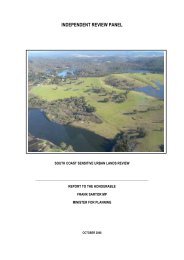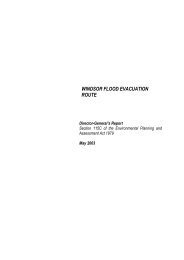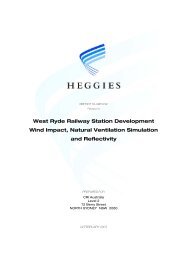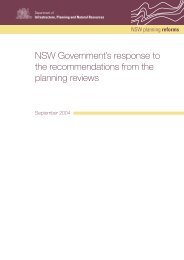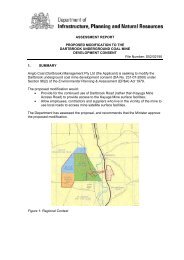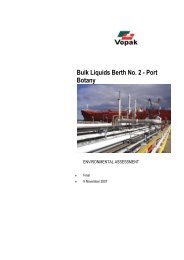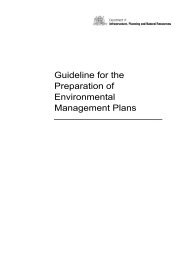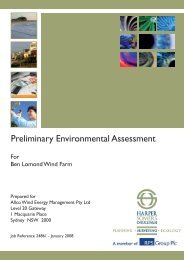Preliminary Hazard Analysis - Department of Planning
Preliminary Hazard Analysis - Department of Planning
Preliminary Hazard Analysis - Department of Planning
Create successful ePaper yourself
Turn your PDF publications into a flip-book with our unique Google optimized e-Paper software.
E N V I R O N M E N T A L A S S E S S M E N T<br />
Chapter 18<br />
<strong>Preliminary</strong> <strong>Hazard</strong> <strong>Analysis</strong><br />
A total <strong>of</strong> 17 hazards were identified for the peaking power plant. These hazards are listed in Table<br />
18-2 below. For each <strong>of</strong> the hazards identified, potential causes, possible consequences and relevant<br />
prevention / protection measures are detailed within Appendix H.<br />
Table 18-2<br />
Summary <strong>of</strong> Identified <strong>Hazard</strong>s<br />
Number<br />
<strong>Hazard</strong>ous Event Potential<br />
Offsite Impact<br />
Potential<br />
1 Loss <strong>of</strong> containment <strong>of</strong> distillate during unloading and storage Y<br />
2 Loss <strong>of</strong> containment <strong>of</strong> distillate during fuel forwarding to gas turbine Y<br />
3 Loss <strong>of</strong> distillate inside gas turbine enclosure Y<br />
4 Unburned distillate inside gas turbine enclosure Y<br />
5 Loss <strong>of</strong> lube oil inside gas turbine enclosure Y<br />
6 Loss <strong>of</strong> containment <strong>of</strong> corrosive liquids N<br />
7 Violent reaction between incompatible materials N<br />
8 Loss <strong>of</strong> containment <strong>of</strong> water treatment plant effluent N<br />
9 Fire at step-up transformers Y<br />
10 Flooding results in process upsets and damage to plant and equipment Y<br />
11 Land subsidence, earthquake or mining activity results in plant damage Y<br />
12<br />
13<br />
Aircraft crash results in process upsets, potential damage to process / piping /<br />
storage facilities resulting in hazardous releases<br />
Damage to plant through terrorism / vandalism / unlawful entry to site /<br />
sabotage<br />
14 Bush / grass fire Y<br />
15 Storm damage Y<br />
16 Incident during maintenance and repair work Y<br />
17<br />
Transport <strong>of</strong> potentially hazardous material to and from the site (diesel, oils,<br />
corrosives)<br />
Y<br />
Y<br />
Y<br />
18.5 Consequence and Frequency <strong>Analysis</strong><br />
For distillate (a combustible liquid), credible incidents arise from ignition <strong>of</strong> leaks or spills, giving rise to<br />
pool fires, where a liquid pool burns at its surface. Pool fires can occur within tanks, in the bunds<br />
around tanks or elsewhere that a pool <strong>of</strong> liquid collects.<br />
PHAs focus on the risk to surrounding land use from a potentially hazardous development. Analysing<br />
the incident scenarios summarised in Table 18-2 above shows that the bund fire scenario caused by a<br />
loss <strong>of</strong> containment <strong>of</strong> distillate during unloading and during storage has the potential to reach outside<br />
the site boundaries.<br />
The likelihood <strong>of</strong> ignition depends on the properties <strong>of</strong> the material, and the size and location <strong>of</strong> the<br />
leak. In the case <strong>of</strong> distillate, the ignition source must be very strong (high in energy) and the material<br />
would most likely need to be heated to above its flash point before ignition could occur (distillate<br />
flashpoint is about 65 o C). A detailed study <strong>of</strong> storage tank incidents in industrial facilities over a 40<br />
year period showed that lightning was the most frequent cause <strong>of</strong> accident and maintenance error was<br />
the second most frequent cause.<br />
Herons Creek Peaking Power Plant<br />
18-6



